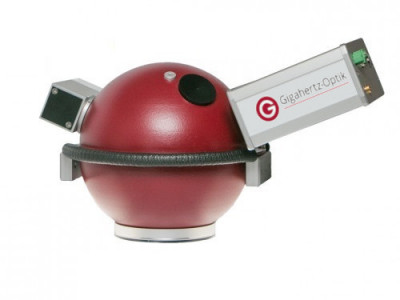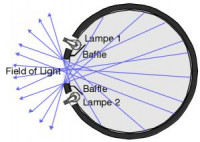6 Theory and Applications of Integrating Spheres
Integrating Sphere Definition
Integrating spheres are very versatile optical elements designed to achieve homogeneous distribution of optical radiation through multiple Lambertian reflections at the sphere’s inner surface. Discover our diverse possibilities in integrating spheres technology.
The ILV (CIE S 017:2020 ILV: International Lighting Vocabulary, 2nd edition) defines it as 17-25-028, integrating sphere or Ulbricht sphere definition: hollow sphere, the interior of which is formed from, or coated with, a diffusely-reflecting material that is as spectrally neutral and as spatially uniform as possible.
Integrating Spheres Coating Material
There are several coating materials available for integrating spheres. Moste used are Barium-sulfate based coatings or PTFE based coatings like our ODM. Different gray levels are also often used. For the IR range often gold coated spheres are first choice. See our Reflectance Materials and Coatings for integrating spheres. See also here typical spectral reflectivities of integrating sphere coating material:
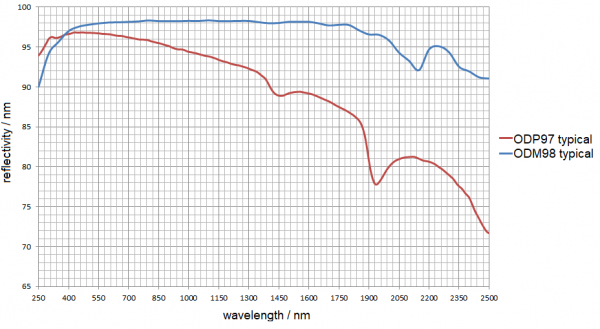
Integrating Sphere Design depending on the Application
There are several designs of integrating spheres possible, depending on the application or use. The integrating sphere is probably most frequently used as a detector of total luminous flux or total radiation power. However, its application as a homogeneous or uniform light source or as a measurement geometry for transmission, absorption and scattering are also very common. Of course, in all applications, very different and specific geometries and characteristics of the integrating spheres are possible and needed.
- Application as integrating sphere detector (ISD) for total radiant flux or luminous flux and also colorimetric measurements usually 2Pi (light source on the entrance port of the sphere, e.g. LEDs) or 4Pi designs (light source inside the sphere) are selected. See our technical article about integrating sphere detector design and our Broadband Light Meters with Integrating Sphere or Integrating Sphere Based Spectroradiometer Systems. The primary radiation source can either be located inside the sphere or in front of the source’s entrance port. In the latter, only the optical radiation entering the sphere is relevant for the sphere’s internal radiation distribution. Illustration of integrating sphere 2Pi and 4Pi design:
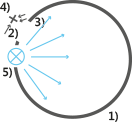
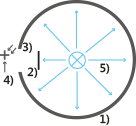 As well accessories aus auxiliary lamps for self-absorption correction, baffles or port reduces, multiple ports, etc. are very common.
As well accessories aus auxiliary lamps for self-absorption correction, baffles or port reduces, multiple ports, etc. are very common. - Application as integrating sphere uniform light source (ISS) the light source is usually in the integrating sphere. See also our technical article about the design of integrating sphere sources and our Integrating Sphere Light Sources. Here the sphere acts as a uniformity generator and mixing devices (reduces coherence). Many different light sources like LEDs, halogen lamps, etc. are possible.
- Integrating sphere for material characterization (ISM) special designs for reflection, transmission and absorption are possible. This is also expressed in our technical article of integrating spheres for material characterization and our products in this category Integrating Spheres for Reflection, Transmission and Absorption. Beside this classical measurement geometries like 8°/d also fluorescence measurements are possible. New approaches also allow the determination of material properties like scattering and absorption coefficients.
- For some applications as for instance Laboratory and Analysis Systems special Integrating Sphere Configurations are needed. We offer for such challenges our Integrating Sphere Construction Kit, which allows individual needed configurations to meet your needs. With this construction kit individual designs are possible of:
- Integrating sphere diameter
- Entrance port sizes an positions
- Exit port sizes and positions
- Coating material
- Accessory
- Light sources used
- Calibration (e.g. ISO 17025 traceable integrating sphere calibrations)
- For the application of SSL/LED measurements, see our technical article LED/SSL testing.
Theory and Real Integrating Spheres
The theory of an integrating sphere allows some basic calculations about integrating sphere throughput, multiplier, etc. However in reality always imperfections, ports, baffles, etc. are needed and the real sphere will behave differently. Sour our information describing the integrating spheres theory and the real integrating sphere model. Of interest are also correction methods as the self-absorption correction, also sometimes called substitution correction.
As long as we restrict ourselves to those regions that are shielded from direct irradiation by the primary source and are thus only illuminated by reflections at other of the inner surface, the theory of the ideal integrating sphere leads to two important conclusions:
- Irradiance of the sphere’s inner surface is proportional to the total radiant power either emitted by a source inside the sphere or entering the sphere through its entrance port. Geometrical and directional distribution of the primary source’s radiation do not influence irradiance levels as long as direct illumination of the respective location is prevented. This property becomes important particularly when an integrating sphere is used as the input optical element of a detector for radiant power.
- Radiance reflected by a region of the sphere’s inner surface shielded from direct illumination is constant in its directional distribution and independent from the specific location where the reflection occurs. Thus, the sphere’s exit port can be used as an ideal Lambertian source since optical radiation leaving the sphere is characterized by homogenous radiance and exitance distributions. This property becomes important particularly when a sphere is used as a standard calibration source.
A document about the thoery and application of integrating spheres is prepared by the CIE International Commission on Illumination. See the document of the CIE about measurement of luminous flux from 1989. Currently a update is prepared called Integrating sphere photometry and spectroradiometry.
Integrating Sphere Application Examples
Integrating sphere source (ISS) as uniform light source
Integrating sphere with LED light source, variable aperture for remote intensity control and spectral irradiance reference sensor:
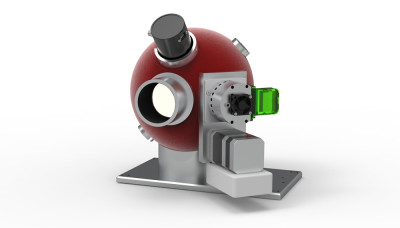
Integrating sphere detector (ISD) example system for LED spectroradiometric measurements
2Pi geometry integrating sphere detector with auxiliary lamp for self-absorption correction, array-spectralradiometer for high speed testing and downward measurement port for system integration.
